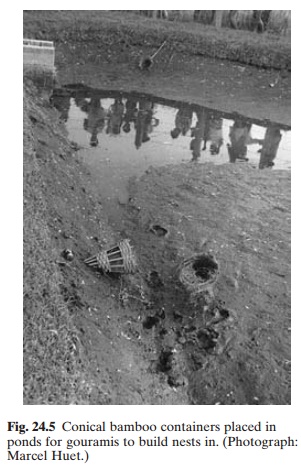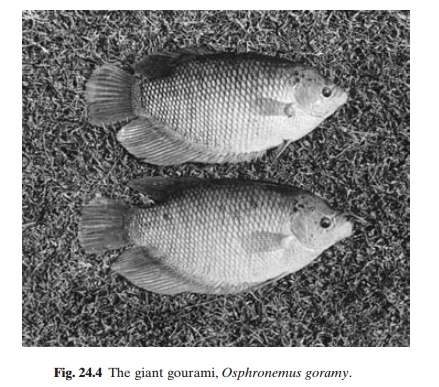Chapter: Aquaculture Principles and Practices: Other Finfishes
Spawning and fry production of Gouramis
Spawning and fry production
In nature, the giant gourami spawns during the dry season but in ponds in spawns throughout the year, in submerged nests made of plant material. Spawners are generally two to three years old, and both female and male parents guard the progeny. The fecundity of the species is not very high and it is reported that a five-year-old female produces only 3000–5000 fry per year in two or three spawnings at bi-monthly intervals. The simplest system of breeding adopted is the provision of suitable water plants or other material for nest making and ensuring that the ponds contain enough male and female spawners, usually in the ratio of 1 : 2 or 2 : 3. Ponds of various sizes with growths of macro-vegetation along the margins are used for spawning, and in certain areas in Java the species is bred with the cyprinid nilem, Osteochilus hasselti, in the same pond. In orderto make nest-building material available, farmers in Java place palm fibres on bamboo poles in the pond. Some farmers place conical bamboo containers at depths of about 30 cm, inside which nests are made with water plants (fig. 24.5). The nests are spherical and measure 30–35 cm in diameter with the opening at the bottom. It usually takes about 10 days to make the nests and spawning takes place two or three days after the nests are ready. A characteristic fishy smell and an oily substance that emanates from the nest indicate that spawning has taken place. The eggs hatch out and hatching becomes

clearly
visible in two to three days. The hatching rate and larval survival can be
increased by removing the fertilized eggs and hatching them indoors. While ants
are considered to be the best food for larvae, peanut waste is sometimes used
as a substitute. At about 1 cm length, the larvae are transferred to rearing
ponds and raised until they reach the size of 2 cm. The fry are usually fed on Azolla or minced leaves of other plants.
Several variations of these methods followed in Java are described by Hora and
Pillay (1962).
The
Siamese gourami spawns in floating bubble nests made by the male in 70–100 cm
deep spawning ponds. Spawners are usually about seven months old and about 100
g in weight. The fecundity of the species varies between 20 000 and 40 000 eggs
per fish of 90–120 g weight. The nest, which consist of a mass of bubbles,
takes about two days to make and, when ready, the female lays the eggs under it
where they float and are immediately fertilized by the male. Hatching may take
one to three days and about 4000 fry can be expected from each nest.

Farmers
who grow the species in rice fields do not spawn them in separate ponds, but
the spawners are first kept in small ponds for some time under crowded
conditions without any supplementary feeding. This is done to make them lean in
the belief that lean fish are better brood fish. They are then released into
the peripheral ditches of the rice field. After a certain period of time, the
fields are flooded to submerge the central raised portion of the field covered
with weeds. The fish migrate to the weed patches, build bubble nests among them
and spawn. The eggs hatch out in about 24 hours. On about the sixth day, when
the yolk sacs are fully absorbed and the larvae measure 5–6 mm in length,
feeding starts. The main source of larval nutrition is the live food produced
in the field as a result of green manuring (with the cut weeds that the farmer
piles up in the fields).
Spawning
of kissing gourami is undertaken in either separate spawning ponds or harvested
rice fields. In Indonesia, the spawning ponds vary in size from 30 to 100 m2
in area, with a supply of clear water. Rice straw or banana leaves are spread
on the pond to provide shade for the eggs and to protect the larvae. Twelve-to
eighteen-month-old spawners of about 20 cm length and 150 g weight are held in
segregation ponds for a period of about a month, after which they are released
into the spawning ponds. Spawning takes place in about 18 hours and the larvae
hatch out in less than two days. The ponds are manured with decaying plant
material about 7–10 days after larvae have hatched out, to develop enough
planktonic food for the larvae. The usual larval rearing period is about 30
days and during this period manuring may be repeated several times.
Related Topics